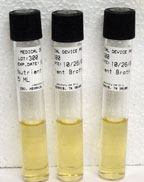Imagine traveling from coast to coast, passing from hand to hand, pocket to pocket, purse to purse. Dropped on the streets of New York City, and then picked up by a homeless guy as a token of good luck. We really can't know everywhere money goes. So it makes sense to be concerned about the bacteria these coins pick up along their travels.
In our Microbiology Lab this semester we will be discovering what kind of bacteria is living on this not so innocent coin. In addition, and more importantly, we will be using multiple tests and procedures over the weeks to identify an unknown bacteria provided to us by our Professor.
So let us begin.
Our first week we spent learning lab safety rules such as washing your hands before you begin and after you finish your work, as well as before you leave the lab for our safety, and the safety of others. Also, we learned how to decontaminated out work surface, before and after completing our lab work.
We also learned the Aseptic technique, which is a process used to inoculate culture media with specific bacteria without introducing contaminating microbes.
 |
| Aseptic Technique |
 |
| Autoclave |
In addition, we learned different methods of sterilization, such as the autoclave, which creates moist heat at temperatures high enough to kill all bacteria, including endospores. Steam under pressure at 15 lb/ in^2 creates the needed temperature of 121 degrees Celsius. Media, glassware, and cotton swabs are routinely sterilized in an autoclave; it is also used to sterilize contaminated glass tubes and Petri plates.
We also learned about the dry heat method, which uses a hot air oven that reaches the required temperature of 160-180 degrees Celsius. And also, filtration which sterilizes by physically removing microorganisms from solutions with solutes that cannot withstand high temperatures.
Finally we learned how to prepare culture media; which is a sterile media that provides nutritional requirements for cultivation of bacteria.
The four kinds of containers with culture media are:
 |
| Broth Tube |
 |
| Agar Deep |
 |
| Agar Slant Tube |
 |
| Agar Plate |
